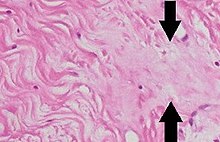
Homogenization, in cell biology or molecular biology, is a process whereby different fractions of a biological sample become equal in composition. It can be a disease sign in histopathology, or an intentional process in research: A homogenized sample is equal in composition throughout, so that removing a fraction does not alter the overall molecular make-up of the sample remaining, and is identical to the fraction removed. Induced homogenization in biology is often followed by molecular extraction and various analytical techniques, including ELISA and western blot.
Methods
Homogenization of tissue in solution is often performed simultaneously with cell lysis. To prevent lysis however, the tissue (or collection of cells, e.g. from cell culture) can be kept at temperatures slightly above zero to prevent autolysis, and in an isotonic solution to prevent osmotic damage.
If freezing the tissue is possible, cryohomogenization can be performed under "dry" conditions, and is often the method of choice whenever it is desirable to collect several distinct molecular classes (e.g. both protein and RNA) from a single sample, or combined set of samples, or when long-term storage of part of the sample is desired. Cryohomogenization can be carried out using a supercooled mortar and pestle (classic approach), or the tissue can be homogenized by crushing it into a fine powder inside a clean plastic bag resting against a supercooled solid metal block (more recently developed and more efficient technique).
High-pressure homogenization is used to isolate the contents of Gram-positive bacteria, since these cells are exceptionally resistant to lysis, and may be combined with high-temperature sterilization.
Dounce homogenization is a technique suitable for soft mammalian tissues, while lysis of mammalian cells has also been demonstrated via centrifugation.
References
- Schmidt SD, Nixon RA, Mathews PM (2012). "Tissue Processing Prior to Analysis of Alzheimer's Disease Associated Proteins and Metabolites, Including Aβ". Amyloid Proteins. Methods in Molecular Biology. Vol. 849. pp. 493–506. doi:10.1007/978-1-61779-551-0_33. ISBN 978-1-61779-550-3. PMID 22528111.
- Chang, Ta-Yuan; Limanek, James S.; Chang, Catherine C.Y. (1 September 1981). "A simple and efficient procedure for the rapid homogenization of cultured animal cells grown in monolayer". Analytical Biochemistry. 116 (2): 298–302. doi:10.1016/0003-2697(81)90360-2. PMID 6119045.
- von Ziegler, Lukas M.; Saab, Bechara J.; Mansuy, Isabelle M. (March 27, 2013). "A simple and fast method for tissue cryohomogenization enabling multifarious molecular extraction". Journal of Neuroscience Methods. 216 (2): 137–41. doi:10.1016/j.jneumeth.2013.03.005. PMID 23541735. S2CID 34417825.
- Wuytack, Elke Y; Diels, Ann M.J; Michiels, Chris W (1 August 2002). "Bacterial inactivation by high-pressure homogenisation and high hydrostatic pressure". International Journal of Food Microbiology. 77 (3): 205–212. doi:10.1016/S0168-1605(02)00054-5. PMID 12160080.
- Singh, Kaustub; Gupta, Ankur; Buchner, Abel John; Ibis, Fatma; Pronk, Joachim W.; Tam, Daniel; Eral, Huseyin Burak (1 July 2019). "Analysis of centrifugal homogenization and its applications for emulsification & mechanical cell lysis". Journal of Colloid and Interface Science. 547: 127–135. Bibcode:2019JCIS..547..127S. doi:10.1016/j.jcis.2019.03.036. PMID 30952074. S2CID 96448552.